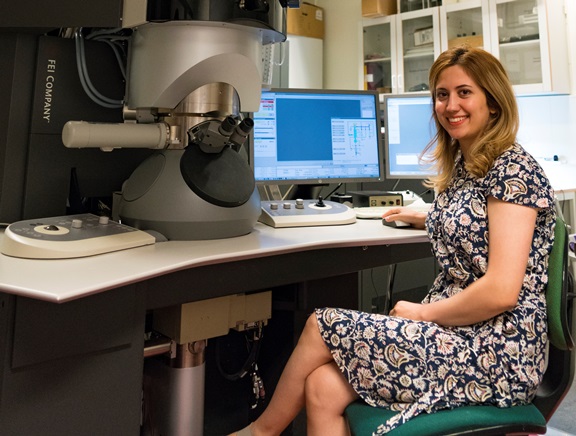Researchers at the Chalmers University of Technology (Gothenburg, Sweden) have developed a superior method to create high-temperature Al alloys by creating stronger adhesion for the oxide scale, which could lead to longer-lasting corrosion resistance.
With research conducted using scanning transmission electron microscopy (STEM), the team says a better, more protective oxide scale can be achieved by controlling the size distribution of reactive element particles used in the high-temperature alloys. These types of alloys are prevalent in many industrial sectors and applications.
“Adding reactive elements to alloys results in a huge improvement in performance—but no one has been able to provide robust experimental proof why,” says Nooshin Mortazavi, materials researcher at the university’s physics department and first author of the study.1 “Likewise, the role of water—which is always present in high-temperature environments in the form of steam—has been little understood.”
Corrosive Conditions
At high temperatures, the researchers explain, alloys can react violently with their environment, which can quickly cause the materials to fail by corrosion.
To protect against this, alloys designed for high-temperature environments are typically designed to form a protective oxide scale, usually consisting of aluminum oxide (Al2O3) or chromium oxide (Cr2O3), to resist oxidation. To enhance the adherence of the protective scale, commercial Al-forming alloys typically include reactive elements added to the mix, such as Y and Zr.

Because the oxide scale plays a key role in preventing corrosion at high temperatures, the researchers sought to find more information on the specific conditions in which they form, and also when they fail. To measure this, three Al-forming alloys were exposed to water vapor in a lab environment at 900 and 1,000 °C for up to 1,000 h, and monitored through STEM equipment.
Team's Findings
The key finding, according to the researchers, was that the presence of the Y and Zr particles caused the oxide scale to grow inward, rather than outward. This facilitated the transport of water toward the alloy substrate. From there, the reactive elements and water combined to create a fast-growing, nanocrystalline oxide scale.
This inward growth comes in contrast to other metastable aluminas that typically form during oxidation.
“We conclude that [reactive element] doping causes outward alumina growth during early oxidation to change into predominantly inward growth, and suggest that this promotes scale adhesion by avoiding the porous scale/alloy interface typical for outward grown scales,” the researchers write in their findings. “This scenario is supported by the observation that Y and Zr are present in the form of nanosized oxide particles in the alloy matrix with no evidence for dissolved Y or Zr.”
In effect, the new inward method—which replaces the inner cathode with an outer cathode—leads to superior adhesion for the protective scale.
Although growth of the oxide through this inward process initially leads to a more adhesive scale, the researchers say there can eventually be a risk of corrosion from adding a concentration of reactive elements that is too high.
For example, in their experiments, an excessive supply of reactive elements often led to the formation of large columnar grains, with some as large as 300 nm. The particles near that size often led to cracks in the oxide scale, whereas the smaller particles of just a few nanometers generally did not.
The researchers referred to this dynamic as “local overdoping” of the reactive elements. Once cracks appeared, a route was provided for corrosive gases to react with the alloy substrate, which caused rapid corrosion, according to the research team. Further research is planned to determine the exact concentrations at which the larger grains, which led to cracks, would form.
“We are now establishing new principles for understanding the degradation mechanisms in this class of materials at very high temperatures,” Mortazavi says. Because the researchers have a better understanding of the processes forming the protective scale, they now believe they can better customize it for more durability.
In their findings paper, the researchers suggest the “inner cathode” concept could also be applied to the likely effect of water on the oxidation of other alloys and claddings. Other feasible areas of study include whether the principles are applicable to other reactive elements besides Y and Zr, and if the dynamics remain similar when alloys are exposed to even higher temperatures.
“We think this is a paradigm shift in the field of high-temperature oxidation,” Mortazavi says.
Research Location, Partners
The research was carried out at the school’s High Temperature Corrosion Center (HTC), as part of a collaboration between the university’s chemistry and physics departments and materials manufacturer Kanthal (Hallstahammar, Sweden). Findings were published in the technical journal Nature Materials.
The HTC is jointly funded by the Swedish Energy Agency (Eskilstuna, Sweden), 21 industry companies who are members of the HTC, and Chalmers. Meanwhile, Mortazavi also received separate funding for her research from the government’s Swedish Research Council (Stockholm, Sweden) and a pair of foundations.
Source: Chalmers University of Technology, www.chalmers.se/en.
Reference
1 “Superior Alloys Could Be Possible, Thanks to Ground-Breaking Research,” Chalmers University of Technology News, June 19, 2018, https://www.chalmers.se/en/departments/physics/news/Pages/Ground-breaking-discoveries-could-create-tougher-alloys-with-many-applications.aspx (July 9, 2018).